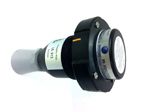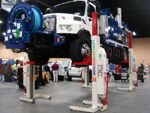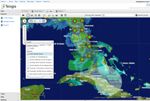Near-, mid- and long-term alternative fuel technologies are available and under development at Ford Motor Company, reported Jim Michon, truck fleet marketing manager, during a presentation at the 2012 Electric Utility Fleet Managers Conference. “In the near term,” he said, “we are migrating to advanced technology. In the midterm we plan full implementation of known technology, and long term we will continue to leverage hybrid technologies and deploy alternative energy sources.”
Specific technologies Ford is addressing, according to Michon, include advanced gasoline and natural gas engines, hybrids, electrified vehicles, fuel cells and hydrogen-powered engines. The company’s path to sustainability also covers body structures, including high-strength steel and aluminum used presently, and the potential for ultrahigh-strength steel, high-strength aluminum, high-temp and reinforced plastics, magnesium and carbon fiber, and bio-based components.
Ford is also targeting aggressive levels of aerodynamic improvements and working on a variety of technologies, Michon noted. Included are auto start-stop, active transmission warm-up, grille shutter, deceleration fuel shutoff, electric power-assisted steering and battery management systems.
Michon also discussed Ford’s EcoBoost family of turbocharged, direct-injected gasoline engines, which the manufacturer claims can provide up to 20 percent better fuel economy without sacrificing power.
In an EcoBoost engine, energy from the exhaust is used to rotate a turbine coupled to a compressor that pressurizes the incoming air, significantly increasing the engine’s power output. Highly pressurized fuel is injected directly into the combustion chamber of each cylinder rather than mixing with the incoming air in the inlet port. The advantage, according to Ford, includes more precise delivery of fuel for lower emissions, improved efficiency and avoidance of knock.
Visit www.fleet.ford.com for more.
Test Drive: Chevrolet Malibu Eco
Billed as the most fuel-efficient Malibu ever, the 2013 Chevrolet Malibu Eco with eAssist technology lived up to the manufacturer’s estimated 37 mpg on highway in a weeklong test drive. The 2013 Malibu Eco is the first Chevrolet to feature eAssist. Along with specific aerodynamic enhancements, according to the OEM, it achieves 12 percent greater highway fuel economy than current models equipped with the 2.4-liter engine.
“Malibu Eco’s eAssist system integrates regenerative braking with the latest lithium-ion battery technology to give our customers significant fuel-efficiency gains,” said Steve Poulos, global chief engineer of eAssist. “Providing electric boost to the powertrain system during heavy acceleration and grade driving helps the transmission operate more efficiently. The engine’s start-stop and fuel shutoff during deceleration features add to the fuel savings.”
The eAssist system is made up of a 32-cell, 0.5-kW lithium-ion battery, an electric motor-generator and a six-speed transmission. The system’s electric motor-generator is mounted to an Ecotec 2.4-liter, four-cylinder engine, in place of the alternator, to provide both motor assist and electric-generating functions through a revised engine belt-drive system.
“The battery system is designed to provide power assistance to the internal combustion engine, rather than storing energy for all-electric propulsion,” said Poulos. “It’s really an extension of the conventional internal combustion engine, not a replacement for it.”
The motor-generator in the eAssist system is a liquid-cooled induction model that bolsters the engine with approximately 11 kW (15 HP) of electric power assist during heavy acceleration and 15 kW of regenerative braking power. This power capability enables the battery to capture energy during regenerative braking.
The air-cooled 115-V lithium-ion battery in the Malibu Eco is integrated into a power pack located in a compartment between the rear seat and trunk. The power pack is cooled by an electric fan that draws air from a vent located in the package tray, behind the rear seat.
Additional fuel-saving features on the Malibu Eco, according to the manufacturer, include an aerodynamically optimized exterior, underbody panels, and electronically controlled shutters in the lower grille that close at higher speeds to push more air over and around the vehicle. In addition, lightweight components and systems – including an aluminum hood, aluminum rear bumper beam, low-mass carpet and dash mat, and more – save approximately 130 pounds compared to comparably equipped non-Eco models.
An Eco gauge in the Malibu Eco’s instrument cluster continuously responds to driving behavior and encourages fuel-efficient driving. A power flow display in the driver information center indicates if the Malibu Eco is operating in battery-charging, electric-assist or auto-stop mode.
The eAssist system works with Malibu’s 2.4-liter Ecotec four-cylinder engine rated at 182 HP and 170 pounds per feet of torque. The Hydra-Matic 6T40 six-speed transmission in the vehicle features changes to clutch controls and hardware to reduce spin losses while improving shift response. The eAssist system’s electric assistance at cruising speeds allows the driver to accelerate lightly or ascend mild grades without the transmission downshifting, and automatic grade braking keeps the transmission in a lower gear when decelerating or coasting on a downgrade. eAssist technology also allows for a numerically lower 2.64 final drive ratio.
The Malibu Eco in our test drive also lived up to the manufacturer’s claim of achieving up to 580 highway miles between fill-ups despite a smaller fuel tank than other 2013 Malibu models at just 15.8 gallons. “It’s a very integrated powertrain system, with no compromises in driving performance, shift quality, or ride and handling,” said Todd Stone, Malibu lead development engineer. “We believe this combination points to the future of vehicles powered primarily by an internal combustion engine.”
Visit www.gmfleet.com for more.
Eaton Makes Multiple Enhancements to Its Hybrid Power System
To increase the fuel economy, performance and payback of its hybrid power system for commercial vehicles, Eaton Corporation has announced a number of enhancements. Included are a new high-capacity battery, a new single-phase 115-V AC auxiliary power generator (APG), a higher-capacity clutch to expand applications up to 860 pounds per feet of torque and a new remanufactured battery for aftermarket purchase.
At the heart of Eaton’s new high-capacity lithium-ion battery is the latest battery cell architecture. The new design increases the fuel savings of Eaton’s hybrid power system an additional 5 to 10 percent, the company noted, while more than doubling the engine-off capability of the system for job site operations.
Eaton is also introducing a new single-phase, 5-kW APG. The APG option converts high-voltage DC current from the battery to 115-volt AC current that can be used by any number of tools on the job site. The APG unit is more compact and 25 pounds lighter than Eaton’s previous offering, which increases flexibility of installation.
The new high-capacity battery and APG will be rolled out during the fourth quarter of this year for utility vehicle applications. Eaton is also now offering higher-capacity clutches that can handle engines up to 860 pounds per feet of torque and 300 HP. Eaton has begun offering a remanufactured battery.
Eaton hybrid power systems have collectively accumulated more than 300 million miles of service. More than 6,000 of Eaton’s hybrid systems are in use today in trucks and buses in a variety of applications.
Yosemite Turns To Eaton For Cleaner Vehicles
Yosemite National Park now allows visitors to enjoy its pristine surroundings onboard new low-emission vehicles powered by Eaton’s hybrid electric systems. Eaton worked with the U.S. General Services Administration and Delaware North Companies Parks and Resorts, which handles the majority of the park’s transportation needs, to deliver four new Class 8 tractors with the Eaton systems. An additional seven vehicles – 37-passenger shuttle buses – are on order.
“The low-speed, low-mileage and stop-and-go duty cycles at Yosemite provide the perfect operating conditions for a hybrid truck,” said Kevin Snow, chief engineer for hybrid applications at Eaton. “On top of that, the environmental and fuel consumption improvements are going to be quite substantial.”
Dan Anthonijsz, village garage manager at Yosemite for Delaware North Companies, agrees. “We are definitely realizing fuel consumption reductions, currently averaging about 6.7 miles per gallon with the tram tractors,” he noted. “That’s a huge improvement over the one mile to the gallon that we were getting with the propane trucks that the new vehicles replaced.”
In addition, Eaton worked with park officials to install a new engine brake on a tow truck with an Eaton hybrid electric system to ensure the regenerative braking function was operating properly. Regenerative braking allows the hybrid system to recover power normally lost during braking and stores the energy in batteries to provide engine-off power takeoff capabilities.
Visit www.eaton.com/hybrid for more.
Terex Hybrid System Retrofit Program
Terex Utilities now offers customers the option to retrofit utility trucks with the Terex HyPower Hybrid System, a plug-in power takeoff system that uses stored energy from the system’s rechargeable batteries to power the nonpropulsion functions of most utility vehicles.
The Terex HyPower Hybrid Retrofit Program can be applied to any Terex or competitive manufacturer’s aerial devices 5 years old or newer and can be completed at any of 14 Terex Equipment Services locations. For an aerial device to be considered for a HyPower retrofit, it needs to pass an initial inspection, which covers the truck’s available payload capacity, body configuration and cab-to-axle length to accommodate the battery packs. After the inspection, retrofits can be completed in as little as two weeks.
HyPower retrofitted trucks come with the standard one-year warranty from the date of in-service on the system, the same as on new HyPower equipped units.
City of Longmont, Colo., Adds Terex HyPower Trucks
Terex Utilities has sold four trucks equipped with its HyPower Hybrid System – a Terex Commander C4047 digger derrick, a Terex Hi-Ranger TCX55 bucket truck and two competitive bucket trucks retrofitted with the HyPower system – to the City of Longmont, Colo.
“We are constantly looking at the emerging technologies like the Terex HyPower Hybrid System to see what would be a good fit for Longmont,” said Deborah Cameron, customer services and marketing manager for Longmont Power & Communications. “LPC crews like that they do not have to yell over engine noise for material or direction with the Terex trucks. They also appreciate that there is no reduction in the performance of the controls while the trucks are in hybrid mode.”
The service area that LPC covers is compact so city crews do not have long drives to work sites, which, according to Cameron, made the Terex HyPower system, with its separate batteries, a smart choice. One of the retrofitted bucket trucks serves as a service truck, taking care of outages and daily calls. The other is the city’s streetlight truck. The TCX55 bucket truck is primarily used by the city’s maintenance crew.
To offset the expense of the Terex HyPower Hybrid trucks, the City of Longmont received $70,000 through the Regional Air Quality Council. In the future, Cameron noted, the city will evaluate opportunities to add more Terex HyPower trucks to its fleet.
Visit www.terexutilities.com for more.
VIA Motors is demonstrating its extended-range electric pickup truck in a partnership between the manufacturer, the state of Utah and Rocky Mountain Power, a division of PacifiCorp and Utah’s largest electric utility. PacifiCorp is part of a group of utility, government and commercial fleets nationwide participating in an early evaluation of electric work trucks developed by VIA Motors in coordination with the U.S. Department of Energy.
VIA’s VTRUX electric vehicles are equipped with a 402-HP electric motor and will be available with a power export option up to 15 kW. The vehicles can average more than 100 mpg with a daily charge and in zero-emissions mode for a majority of fleet driving, the company said. The manufacturer works with General Motors to incorporate its V-DRIVE powertrain into new GM trucks, vans and SUVs. VIA is planning to sell electrified work trucks to fleets early in 2013.
Visit www.viamotors.com for more.
Allison Transmission Inc. has invested in a noncontrolling equity stake in Odyne Systems LLC. The manufacturer of hybrid control systems designed and developed a plug-in hybrid power system, which interfaces with the Allison family of commercial vehicle transmissions.
Odyne’s proprietary and patented plug-in hybrid drive system, sold through a worldwide distribution network, can be installed on a wide variety of new and existing vehicles. Johnson Controls is the exclusive supplier of lithium-ion batteries for Odyne Hybrid Power systems.
Visit www.odyne.com and www.allisontransmission.com for more.
Quantum Fuel Systems Technologies Worldwide Inc., in association with lithium-ion battery system supplier Dow Kokam, has delivered the first pilot version of its plug-in hybrid electric (PHEV) Ford F-150 pickup truck to Florida Power & Light Company.
The PHEV F-150 is powered by Quantum’s F-Drive parallel plug-in hybrid electric drive system. The F-Drive allows the truck to run the first 35 miles on a zero-emission electric drive and then switch to an efficient hybrid drive mode, achieving more than 100 mpg, according to the manufacturer, depending on the drive cycle and charging frequency.
Visit www.qtww.com for more.
XL Hybrids Inc. has released test results that it said validate a 21.2 percent reduction in fuel consumption with the company’s aftermarket hybrid electric powertrain. XL Hybrids’ powertrain is a bolt-on technology that integrates with an internal combustion engine and transmission.
The tests were conducted on a light-duty chassis dynamometer test cell. The testing process compared fuel economy performance from the vehicle in its original condition with the performance using XL Hybrids’ charge-sustaining hybrid system. The test was completed on a Chevrolet 2500 Express cargo van fitted with the OEM’s 4.8-liter engine and six-speed transmission over a light-duty Urban Dynamometer Driving Schedule test cycle.
Visit www.xlhybrids.com for more.
ALTe Powertrain Technologies, the developer of range-extended plug-in electric hybrid powertrains, has installed its system in the Ford Econoline E-350 platform. ALTe already implemented conversions in Ford F-150 trucks. The manufacturer is delivering an E-350 prototype to a fleet customer for evaluation and plans to build more prototypes for customer evaluations throughout the year, leading to a spring 2013 product launch date for the U.S. market.
ALTe’s road tests revealed that the E-350 cutaway chassis prototype can drive approximately 25 miles in an all-electric mode and then deliver nearly 15 mpg in a charge-sustained mode, the company reported. For a fleet vehicle that drives 45 miles per day, ALTe noted, the combined mode fuel economy would be more than 30 mpg, while a similar Ford E-350 cutaway chassis with a V8 gasoline engine averages fewer than 9 mpg based on data provided by major fleets.
Visit www.altept.com for more.
SCR Engine Update
As a speaker on a “Diesel Engines – Current and Future” panel during the 2012 Electric Utility Fleet Managers Conference, Dave Bryant, vocational sales manager at Freightliner, reported on the performance of 2010 emissions-compliant diesel engines. “There is growing confidence in SCR engine technology,” Bryant said. “Market adoption of SCR engines in six key Class 6-8 vocational applications [refuse, utility, construction, heavy hauling, beverage and municipal] is 39 percent greater than non-SCR engines today compared to 18 percent three years ago.”
Among the findings about SCR engine performance in Bryant’s report were the following:
• Fuel economy in EPA 2010 SCR engines was initially projected to be 3 percent better than 2007 models. Customers in utility truck applications are reporting a 5 percent improvement in actual use.
• In many cases, a three-time reduction in diesel particulate filter (DPF) regeneration cycles between 2007 and 2010 engines is being reported, including Detroit Diesel and Cummins models. DPF regeneration, Bryant noted, requires fuel to clean out unburned fuel, so reducing regeneration frequency also has a fuel economy benefit.
• Better drivability from increased horsepower and better throttle response are evident in 2010 engines, especially in Cummins ISB, ISC and ISL models.
• Durability is improved. Cummins has seen an appreciable reduction in warranty repairs on 2010 engines compared to 2007 models, especially for turbochargers and injectors. Additionally, improved cooling system performance is resulting in reduced heat rejection, causing fewer problems.
• OEMs have addressed packaging and chassis space concerns by providing clear frame rails and back-of-cab surfaces, and by not increasing cab heights.
• DEF infrastructure concerns have turned out to be a nonissue. Meeting fleet needs are bulk DEF, and more than 6,500 DEF retail outlets and 500 pump locations.
“In 2009 we told you that 2010 EPA engines compared to 2007 pre-SCR models would have better fuel economy, improved regeneration frequency, increased power with the same displacement, enhanced drivability and better cooling system performance to reduce heat,” Bryant said. “We also said we would address vehicle packaging concerns and DEF availability issues. All of those challenges have been met.”
Visit www.daimler-trucksnorthamerica.com for more.
Peterbilt Grows Natural Gas Vehicle Market
With a 40 percent market share of the commercial truck natural gas market, including vocational and over-the-road models, Peterbilt Motors Company continues to expand its natural gas-powered vehicle offerings.
Peterbilt currently offers two natural gas engine platforms. The Cummins Westport 8.9-liter ISL G, rated 320 HP at 1,000 pounds per feet of torque, is a spark ignition engine with a three-way catalyst emissions system that can be configured with either LNG or CNG fuel systems. The second platform is the Westport HD 15-liter engine rated 475 HP and 1,750 pounds per feet of torque with diesel pilot ignition configured for LNG fuel systems.
The OEM will also offer the new Cummins Westport ISX12 G in 2013. The engine, rated up to 400 HP and 1,450 pounds per feet of torque, features spark ignition and a three-way catalyst, and can be configured with an LNG or CNG fuel system.
Visit www.peterbilt.com for more.
CARB Retrofit Alternative Fuel System Certification
The California Air Resources Board has approved the ROUSH CleanTech propane autogas fuel system for retrofitting 2010 model year 5.4-liter Ford E-150, E-250 and E-350 cargo vans and wagons. ROUSH CleanTech is also pursuing retrofit certification for 2009, 2011 and 2012 model years of the same Ford models as well as E-450 cutaway vehicle platforms.
The CARB certification is the first awarded since 2000 for a liquefied petroleum gas retrofit system, and the first CARB certification for any alternative fuel system for retrofit installation on 2010 model year vehicles. The number of alternative fuel retrofit certifications awarded has been limited due to stricter regulations implemented in 1994.
ROUSH CleanTech offers a wide range of CARB-certified, dedicated liquid propane autogas fuel systems for pre-title installation, which includes applications for Ford F-250/350 trucks, Ford E-series vans, and Blue Bird Propane-Powered Vision and Micro Bird G5 school buses.
Visit www.roushcleantech.com for more.
Green Facility
Altec Industries has opened a new green-focused facility in Dixon, Calif. The manufacturer is using the 42,400-square-foot assembly plant to expand the development and production of its Green Fleet utility vehicle product line.
Altec received guidance and support on the development of the new green-focused facility from Pacific Gas & Electric Company and Southern California Edison. In addition, PG&E and Altec are partnering to develop Green Fleet utility vehicles, which will be produced at the new plant.
“Altec is committed to sustainable solutions,” said Lee Styslinger III, Altec chairman and CEO. “That commitment to sustainability is reflected not only in the products we build, but also in the facilities where we build them.”
Visit www.altec.com for more.












